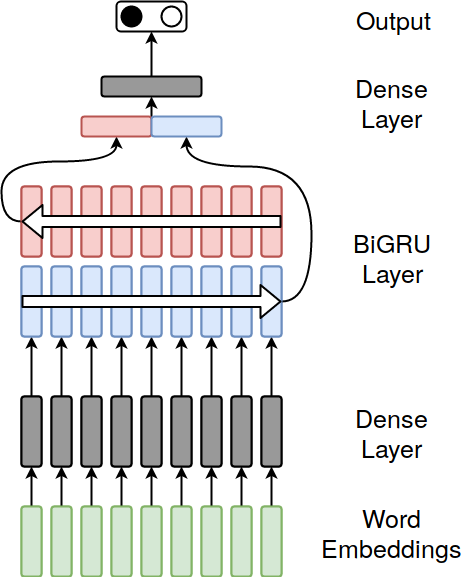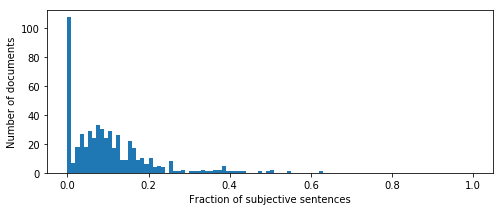virtualenv --python=/usr/bin/python3 .env
source .env/bin/activate
pip install -r requirements.txt
wget http://nlulite.com/download/glove ./data/word_embeddings/In the installed environment you can either provide the text as an argument:
python -m subjectivity.classify this is a test.Or pipe a text file from the command line:
python -m subjectivity.classify < data/random_text.txtThe output will look like the following:
OBJECTIVE SENTENCES
<list of objective sentences in the text>
SUBJECTIVE SENTENCES
<list of subjective sentences in the text>
Trains for 40 epochs
python -m subjectivity.trainTest epoch 29
python -m subjectivity.test10-fold cross validation on the training dataset
python -m subjectivity.cross_validate\newpage
The network structure is as in Fig. 1
A text is divided into sentences. Each sentence is tokenized into words, and each word vector is given as an input to the network.
For the word embeddings I have used the 50-dim Glove vectors trained on [Wikipedia 2014].
Each word embeddings goes through a dense layer. The result is then fed to a bi-directional GRU, effectively composed by a forward GRU and a backward one. The last state of the forward GRU and first state of the backward GRU are concatenated and fed into one last dense layer, which is finally projected with a softmax into a binary vector.
This last vector represents the predicted class: [1, 0] predicts a subjective sentence, [0, 1] an objective one.
| Layer | dimension |
|---|---|
| Word embeddings | 50 |
| Dense layer | 25 |
| GRU memory | 100 |
| GRU stacks | 1 |
| Final hidden dense layer | 200 |
| Output size | 2 |
| Minibatch size | 10 |
| Dropout rate | 0.3 |
\newpage
I used Cornell's [Subjectivity dataset v1.0], which is based on movie reviews taken from IMDB and RottenTomatoes. The dataset contains 5000 subjective sentences and 5000 objective ones (according to their classification).
In order to train and evaluate the result, I have split the dataset into a training set of 4500 sentences for each class (a total of 9000 sentences) and a test set of 500 sentences for each class (1000 sentences total).
The hyperparameter evaluation has been done by using 10-fold cross validation over the training set. Maybe cross validation is a bit overkill for the task at hand, but I wanted to compare my results with the one in the [Liang and Zhang], where they also use 10 fold cross validation.
The current network structure has been taken from [Augensten et al], while the training dataset is the same as in [Liang and Zhang].
This last article uses a system of convolutional nets to decrease the dimension of the input embeddings. Moreover, all the output states of the RNN are used to classify the output, whereas in [Augensten et al] only the initial and final state of the RNN are used.
I decided to use [Augensten et al]'s network topology because it contains less parameters than the one in [Liang and Zhang]. The training data is not abundant and a model with less parameters should perform better.
My feeling is that the training data is not quite as big as it should be, and most of the credit for the results comes from the quality of the pre-trained word embeddings.
\newpage
The best results for the 10-fold cross validation are found in the 29^th epoch of training
| precision | recall | f1 |
|---|---|---|
| 0.913 | 0.914 | 0.913 |
Whereas the results on the test set are
| precision | recall | f1 | accuracy |
|---|---|---|---|
| 0.912 | 0.895 | 0.903 | 0.904 |
For comparison the accuracy in [Liang and Zhang] is 0.943, and the state-of-the-art is 0.95 accuracy in [Zhao and Mao].
I believe that the main reason for the lower quality in the results is due to the fact that I used lower quality word embeddings. Using the Glove 300-dim Common Crawl would have probably given better results (see FAQ answer to question 2).
Another reason is that I optimised for F1 score, not for accuracy.
Two Jupyter notebooks can be found in ./notes/Jupyter/.
The first file simple_test_classification.ipynb is about using the high level classifier
on a simple sentence. The second file plays with the classification of texts taken from the
[MPQA opinion corpus v1.2].
These are freely available texts (used for subjectivity evaluation), mostly related to news.
The second file many_files_classification.ipynb is about measuring the subjectivity of documents.
In order to classifty texts I have tried to measure the fraction of subjective sentences in each document.
The result is plotted in Fig. 2
Naively, a document would be classified as very subjective if it contains a lot of subjective sentences. The simple barchart in Fig. 2 however depicts a multimodal distribution of documents according to this classification metric. This makes sense because the MPQA corpus has documents from different sources, each written with a different style.
Document subjectivity is more complicated than sentence subjectivity and more thinking is necessary to achieve document level classification.

